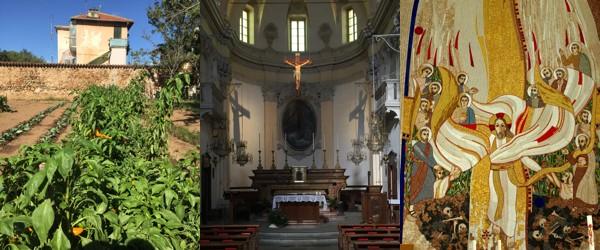Philip Harrison SJ reflects on a long, hot summer in the village of Beinasco on the outskirts of the city memorialised by the film The Italian Job.
A long, hot summer stretched before me as I stepped off the train onto the sun-baked platform, destined for the suburban village of Beinasco on the outskirts of the city of Turin: ‘Let’s go for slice of pizza’, said the parish deacon who had come to collect me from the station. We had last met when I worked in the same parish the previous year, spending a month cycling between its three Mass centres to celebrate the eucharist, funerals and baptisms, listen to confessions, and spend time with the young people of the parish. The kindness of the community and the strength of their faith had won my heart. I had decided to return while I finished off my dissertation for the course of studies I had been undertaking in Rome.
The origins of the parish church of San Giacomo (St James) were lost in the mists of time, as I discovered as I read the meticulous records of the area kept by a previous parish priest. In the room above the sacristy, the deacon was busily restoring the parish library which contained books going back to the seventeenth century, but the earliest record of a church on the site was in 1598. A nearby branch of the famous pilgrimage route that led to the shrine of Santiago de Compostela had given the church its name and brought pilgrims from Rome to the mountain passes that crossed the Alps into France. Gradually, the small, rural settlement had grown to become a suburb of the increasingly industrialised city of Turin, but never lost the atmosphere of a small community.
In the heyday of the city’s car production in the 1970s, Fiat employed more than 100,000 people and produced more than 1.4 million cars in Italy alone, a boom famously memorialised in the film The Italian Job. More than 85% of the population of the village belonged to the families of migrant workers who had arrived in Turin from the south of Italy. Along with their statue of Our Lady of Carmel, they had carried an exuberant faith that mixed with the reserved religiosity of the north, which had developed under the same conditions as the Protestant reform movements. Indeed, a nearby valley was still the home of the Waldensian Church, one of the earliest Protestant sects that had begun as a reaction to the material excesses of the Church in the twelfth century. In 2015, the Waldensian Christians received an apology from Pope Francis, whose ancestors come from the same part of Italy, for the persecution they had suffered.
Following in the footsteps of St John Bosco, whose birthplace was also to be found nearby and who had often preached in the church, the current parish priest Don Gigi dedicates much of his time to working with young people. He told me: ‘We are preparing the hearts of the young to receive the gospel, we don’t need to worry about the future.’ He had organised a pilgrimage to Slovenia for some of them to visit in situ the works of the Jesuit artist Marko Rupnik SJ, whose mosaics adorn cathedrals and chapels across the world. The night before the young people left, we watched a film together about Rupnik’s life and inspiration in which he recounted how his art was born in the conflicts which scarred the former Yugoslavia in the 1990s. On their return, the young people spoke about the wonder they felt to be able to enter into sacred spaces filled with such colour, light and movement. Don Gigi said: ‘Each one of us is a tile in the great mosaic of life, and we all have our special place.’
Luca was a young man from one of the old families of Beinasco who took me under his wing. He had decided to enter the seminary to begin formation as a diocesan priest that autumn. He explained how sometimes he found himself caught between two worlds and had finally realised in which one he belonged. Many young people find their vocation outside of the traditional opportunities offered by the Church, but he had found his within it. It struck me that rather than lamenting the lack of religious and priestly vocations, there was an invitation to honour whichever way young people choose to live the gospel. The personal invitation that Christ offers each one of us leads us to do something utterly unique with our lives that deserves respect.
Each day, I opened the windows overlooking the parish allotment behind the church, where a 92-year-old man arrived every morning and evening to tend the tomatoes, courgettes, aubergines and peppers that grew there. Once the doors of the church were open, a few of the parishioners and I prayed lauds. It filled me with joy to pray together and gave me the energy I needed for the ministry of that day. The sun blazed down and the church heated up throughout the day until it felt like the inside of an oven. Before I closed the doors at the end of the day, we prayed vespers. Each day filled me with joy and life, to be a priest surrounded by a people so kind, whose faith was so strong.
Finally, after two weeks, the rains came and a fresh breeze sprung up from the mountains. As I sat one day with the gospel for the coming Sunday trying to compose a homily, I was inevitably struck by the words: ‘I have come to bring fire on earth, how I wish it were already kindled’. As I sat there, I wondered how to reconcile the peaceful Jesus who I had met in Beinasco with this image of apparent conflict. Then I remembered a story I had once read by one of the Desert Fathers who had gone out into the wilderness in the first centuries after Christ in order to live a life of fasting and prayer. He described the spiritual life in the following way.
Those who look for peace in the Lord are like those who try to light a fire in a forest. Having kindled the fire, they are suffocated by smoke and their eyes begin to sting with tears. After a time, however, they obtain the joy that they desire from the light and warmth of the fire. The same is true of the spiritual life in which, at the beginning, we are suffocated by battles with ourselves, with others and even with God. After a time, the fire within us becomes the source of our life.
The love of Christ is like that fire. Once lit, it begins to burn all the dry wood of our apathy and laziness, of everything within us that does not come from God, until we are ready to find peace. Usually we try to avoid the smoke of the fire, but the young people of this generation, hearts prepared to receive the gospel, are undergoing a transformation. They are becoming luminous signs of faith in daily life with hearts that beat not to the rhythm of the world but to the rhythm of Christ. Their words and actions are becoming signs of the gospel alive in our midst. They bear witness to the struggle in which we are all engaged.
In the homily that Sunday I told the parishioners in Italian: ‘It does not matter what kind of fire Christ has lit within you: a raging forest fire, a flickering candle, or a burning brazier, let yourself burn with the fire of Christ’s love so that you, too, can become a luminous sign of faith in the community where you belong.’
Philip Harrison SJ is a Jesuit of the British Province completing studies at the Pontifical Biblical Institute in Rome.






